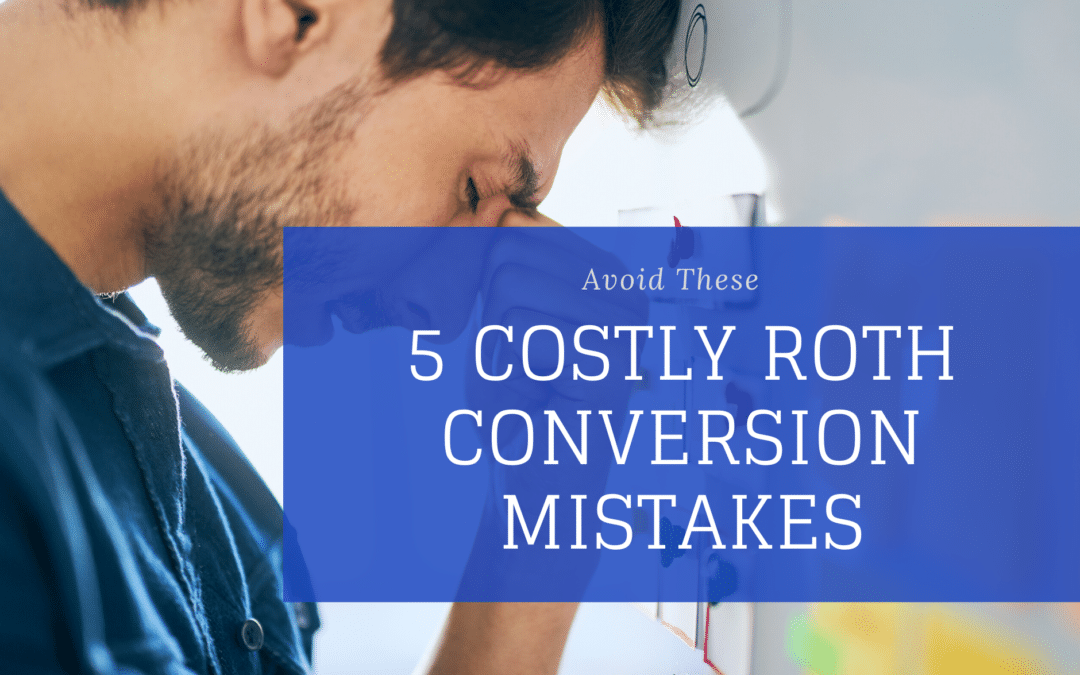A partial Roth conversion is one of my favorite tools to help clients manage their retirement income taxes, so I get frustrated when I see that tool used in the wrong way.
The goal of a partial Roth conversion is to reduce the value a traditional IRA before required minimum distributions begin —thus reducing the size of those RMDs and income tax you pay on them. Because Roth IRAs are funded with after-tax dollars, you pay taxes upfront on your contributions in exchange for a source of tax-free retirement income.
When done correctly, a partial Roth conversion allows you to make smaller tax payments over time to avoid paying a big tax bill later on. But if done wrong, you might leave some of those potential tax savings on the table—or worse. A flawed conversion might even cost you money.
Here are five of the biggest mistakes that can often derail a Roth conversion strategy:
Being unintentional about the conversion.
Too many people pursue a Roth conversion because they’ve heard it’s a good way to avoid taxes. They think any conversion will achieve that goal. The problem is—whether they’re impatient or simply unaware—they don’t do the math to figure out the best strategy for their needs.
Instead of doing small, annual conversions people often convert way too much all at once, bumping them into a higher tax bracket and causing them to pay higher taxes than they’d owe otherwise.
On the other hand, people sometimes convert too little each year, leaving themselves with bigger RMDs and higher tax bills in retirement. The sweet spot is calculating how much extra income you can make in a given year without bumping yourself into a higher tax bracket and then converting that amount.
Paying the conversion taxes with IRA funds.
This is an easy mistake to make—but it’s also easy to avoid. Let’s say you convert $20,000 from a traditional IRA to a Roth IRA and owe $4,800 in taxes. You might decide to just pay the taxes out of that same $20,000 you’re taking out of the IRA. But if you do that, you’re left with only $15,200 to compound, reducing the potential size of your Roth balance by the time you retire.
Pay taxes out of regular cash flow or a non-retirement savings account to ensure you’re getting as much tax-free growth in your Roth IRA as possible.
Converting an IRA that was recently rolled over from a 401(k).
People in their 50s and 60s can be great candidates for a partial Roth conversion. But these same people often have big 401(k) balances that have appreciated over decades of employment. To be clear, rolling over the 401(k) to the IRA isn’t a taxable event, but it does change the equation that determines the amount of your conversion that is subject to taxes.
If someone has recently rolled a highly appreciated 401(k) into a traditional IRA, and then decides to do a Roth conversion from that same IRA shortly after, they’re going to face a bigger tax liability and a higher cost of conversion.
Holding the wrong assets in your Roth account.
You’ve heard of asset allocation and why it matters to your investment strategy. But with a Roth conversion, asset location is just as important. Paying careful attention to asset location is critical for tax-efficient investing. If you hold assets with higher growth potential, such as stocks, in your Roth, you get to maximize the benefits of that account’s tax-free growth. On the flip side, holding bonds and other assets with lower expected returns in a Roth is a waste of that tax-free growth potential. After completing a conversion, adjust both your traditional IRA and Roth portfolios to make sure you’re strategically holding investments in the accounts that offer the greatest advantage.
Going it alone.
This may be the biggest mistake of all—trying to do a Roth conversion without an advisor.
The major risk is that you increase your chances of succumbing to one or more of the mistakes above. But even if you don’t make a costly blunder, going it alone can still mean missing out on optimal results. An experienced advisor can help coordinate a Roth conversion with other powerful strategies, like making charitable gifts through a donor-advised fund or determining the best time to claim Social Security benefits.
Remember, partial Roth conversions are more than just a great tool for managing taxes today and in retirement. When done correctly, they also can have a positive influence on your other financial goals. But partial Roth conversions are also complex. Seeking expert guidance and avoiding these common pitfalls will help you maximize the benefits of this powerful strategy.
Next Steps…
A Roth conversion is just one strategy I can offer to help you maximize how you use your money. There are dozens of strategies you can use at any point in your finance journey – before or after retirement.
If you would like to hear more about how I can help you, book a quick 15-minute call with me.
You may also enjoy the free worksheets and checklists I have that will help you make smart financial decisions like deciding if you should rent or buy a house, determine your net worth, or figure out how much cash flow you have every month.
Additional posts to read for more retirement tips include:
- How an HSA Can Boost Your Retirement Savings
- The Most Important Rule In Planning For Retirement
- The Most Potent Combination For Wealth Creation
…
RESOURCE: Do you want to make smart decisions with your money? Discover your biggest opportunities in just 9 questions with my Financial Wellness Assessment.

This post first appeared on WallStreetJournal.com















Why would’nt you hold bonds in a traditional or Roth IRA? From a tax perspective, why not shelter all the interest income. Stocks have lower dividend rates and subject to lower capital gains rates which would be more favorable in a non retirement account.
Thanks for reading. I wrote about asset location a few years ago (here: https://www.plancorp.com/blog/asset-location-strategies), so that might give you a little more insight.
“If someone has recently rolled a highly appreciated 401(k) into a traditional IRA, and then decides to do a Roth conversion from that same IRA shortly after, they’re going to face a bigger tax liability and a higher cost of conversion.” Why? And would it be better to do a partial Roth conversion straight from the 401(k)?
Excellent and very informative article!
Hi Michael — thanks for reading. Rolling over a highly appreciated 401(k) lowers the basis of your IRA, which is what causes the larger tax liability than if you converted an IRA prior to rolling over your 401(k). In general, converting directly from your 401(k) doesn’t solve for this issue, and in many instances can actually make it worse. I hope this helps. Feel free to visit my Work With Me page if you’d like to learn more about how we help with these decisions.